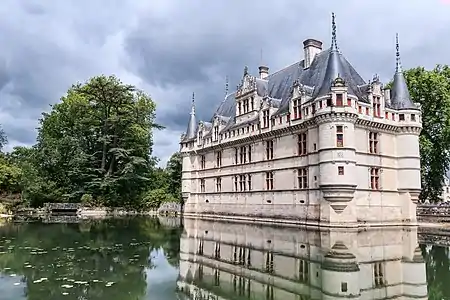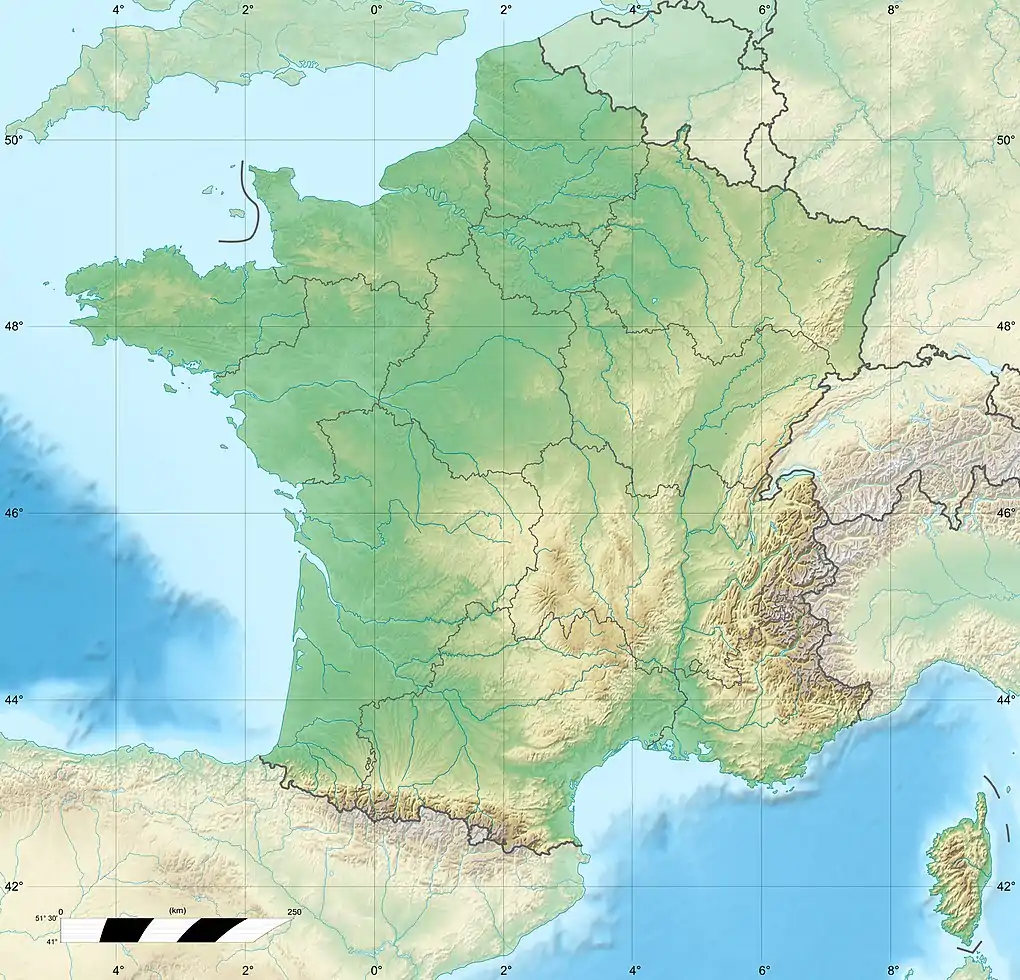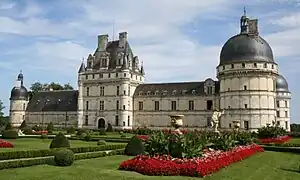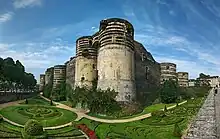| UNESCO World Heritage Site | |
|---|---|
 | |
| Location | France |
| Criteria | Cultural: i, ii, iv |
| Reference | 933bis |
| Inscription | 2000 (24th Session) |
| Area | 86,021 ha |
| Buffer zone | 213,481 ha |
 1 2 Limits of the World Heritage site: 1 = Sully-sur-Loire, 2 = Chalonnes-sur-Loire | |

The Loire Valley (French: Val de Loire, pronounced [val də lwaʁ]; Breton: Traoñ al Liger), spanning 280 kilometres (170 mi),[1] is a valley located in the middle stretch of the Loire river in central France, in both the administrative regions Pays de la Loire and Centre-Val de Loire. The area of the Loire Valley comprises about 800 square kilometres (310 sq mi).[2] It is referred to as the Cradle of the French and the Garden of France due to the abundance of vineyards, fruit orchards (such as cherries), and artichoke, and asparagus fields, which line the banks of the river.[3] Notable for its historic towns, architecture, and wines, the valley has been inhabited since the Middle Palaeolithic period.[2] The oldest known Neanderthal engravings have been found a cave in La Roche-Cotard which have been dated to more than 57,000 years ago.[4][5] In 2000, UNESCO added the central part of the Loire River valley to its list of World Heritage Sites.[1]
Geography and climate
The valley includes historic towns such as Amboise, Angers, Blois, Chinon, Montsoreau, Orléans, Saumur, and Tours.
The climate is favorable most of the year, the river often acting as a line of demarcation in France's weather between the northern climate and the southern.[6] The river has a significant effect on the mesoclimate of the region, adding a few degrees of temperature. The climate can be cool with springtime frost while wine harvest months may have rain.[7] Summers are hot; however, influences from the Atlantic moderate the temperature with breezes.[8]
| Month | Jan | Feb | March | Apr | May | June | July | Aug | Sept | Oct | Nov | Dec | Year |
|---|---|---|---|---|---|---|---|---|---|---|---|---|---|
| Average minimum temperature (°C) | 2.1 | 2.2 | 3.9 | 5.6 | 8.9 | 11.8 | 13.6 | 13.4 | 11.3 | 8.4 | 4.6 | 2.8 | 7.4 |
| Average temperature (°C) | 5 | 5.7 | 8.2 | 10.4 | 13.9 | 16.2 | 19.2 | 19.1 | 16.5 | 12.7 | 8 | 5.6 | 11.8 |
| Average maximum temperature (°C) | 7.9 | 9.2 | 12.6 | 15.3 | 19 | 22.6 | 24.9 | 24.7 | 21.8 | 17 | 11.4 | 8.4 | 16.2 |
| Average monthly rainfall (mm) | 62.1 | 50.8 | 51.7 | 44.6 | 54.4 | 41.2 | 43.8 | 44.9 | 52.2 | 59.6 | 64.5 | 63.4 | 63.4 |
| Monthly hours of sunshine (hour/month) | 70 | 92 | 141 | 179 | 201 | 234 | 248 | 237 | 191 | 129 | 89 | 65 | 1877 |
Wine

The Loire Valley wine region[10] is one of the world's most well-known areas of wine production and includes several French wine regions situated along the river, from the Muscadet region on the Atlantic coast to the regions of Sancerre and Pouilly-Fumé just southeast of the city of Orléans in north-central France. Loire wines tend to exhibit a characteristic fruitiness with fresh, crisp flavors.[11]
Culture
On 2 December 2000, UNESCO added the central part of the river valley, between Chalonnes-Sur-Loire and Sully-sur-Loire, to its list of World Heritage Sites. In choosing this area that includes the French départements of Loiret, Loir-et-Cher, Indre-et-Loire, and Maine-et-Loire, the committee said that the Loire Valley is: "an exceptional cultural landscape, of great beauty, comprised of historic cities and villages, great architectural monuments - the châteaux - and lands that have been cultivated and shaped by centuries of interaction between local populations and their physical environment, in particular the Loire itself."[1]
The Loire Valley chansonniers are a related group of songbooks attributed to the composers of the Loire Valley and are the earliest surviving examples of a new genre that offered a combination of words, music, and illuminations.[12]
A new Contemporary Art offer is developing all along the Loire River from Montsoreau to Orléans with such places as Château de Montsoreau-Contemporary Art Museum, CCCOD Tours, the Domaine Régional de Chaumont sur Loire and the Frac Centre Orléans.[13][14][15] They are a rare association of Renaissance architecture with contemporary art.[16]
Architecture

The architectural heritage in the valley's historic towns is notable, especially its châteaux, such as the Château d'Amboise, Château d'Azay-le-Rideau, Château de Chambord, Château de Chenonceau, Château de Chinon, Château de Montsoreau, Château du Rivau, Château d'Ussé, and Château de Villandry. The châteaux, numbering more than three hundred,[17] include the necessary castle fortifications built in the 10th century but also the splendour of those built half a millennium later. When the French kings began constructing their huge châteaux here, the nobility, not wanting or even daring to be far from the seat of power, followed suit. Their presence in the lush, fertile valley began attracting the very best landscape designers. In addition to its many châteaux, the cultural monuments illustrate to an exceptional degree the ideals of the Renaissance and the Age of the Enlightenment on western European thought and design. Many of the châteaux were designed to be built on the top of hills, one example of this is the Château d'Amboise. Many of the châteaux had extremely detailed and expensive churches on the grounds, or within the actual château itself.
Economy
The European Commission reported that in 2016, three categories accounted for most of the economy in the Pays-de-la-Loire region: services (including tourism) provided 66.7% of employment, industry 26.5% and agriculture, 3.9%. The unemployment rate was 8.8%. In 2015, the region ranked eighth in France in terms of economic performance producing 5.0% of the gross domestic product. Important economic sectors included leather goods, textile, shipyard/construction and aeronautics, agriculture and food-processing as well as the plastics industry.[18] The EC did not produce a report for the larger Loire Valley region.
According to another source, tourism in the Loire Valley was supported by over 700 hotels and 550 restaurants in the region. In addition to the chateaux and some 700 other listed Historic monuments, attractions included three Regional nature Parks, 550 km of cycling tracks, 800 listed Historic monuments, over 100 museums and 30 golf courses.[19]
In April 2019, The Guardian's travel section included one Loire Valley location in its list of 20 of the most beautiful villages in France: Montrésor, "a fairytale village with a rich history" evidenced by "the wool market, the Halle de Cardeux, ... the 16th-century Logis du Chancelier, ... a riverside walk, Balcons de l'Indrois, [and] ... Jardinier Bridge".[20]
According to a 2017 report by CNN, the 42 chateaux that make up the UNESCO World Heritage Site receive over 3.3 million visitors per year.[21] The Daily Telegraph newspaper (2014) listed the following as the premiere chateaux for tourists: Chinon, Cité royale de Loches, Chaumont, Blois, Meung, Chenonceau, Rivau, Lemeré, Amboise, Clos Lucé, Amboise, Chambord, Villandry and Valençay.[22]
See also
References
- 1 2 3 "The Loire Valley between Sully-sur-Loire and Chalonnes". UNESCO World Heritage Centre. United Nations Educational, Scientific, and Cultural Organization. Retrieved 13 November 2021.
- 1 2 Tockner, Klement; Uehlinger, Urs; Robinson, Christopher T. (2009). Rivers of Europe. Academic Press. p. 183. ISBN 978-0-12-369449-2. Retrieved 11 April 2011.
- ↑ Williams, Nicola; Boone, Virginie (1 May 2002). The Loire. Lonely Planet. pp. 7–10. ISBN 978-1-86450-358-6. Retrieved 12 April 2011.
- ↑ Sample, Ian (21 June 2023). "French cave markings said to be oldest known engravings by Neanderthals". The Guardian. ISSN 0261-3077. Archived from the original on 21 June 2023. Retrieved 22 June 2023.
- ↑ Marquet, Jean-Claude; Freiesleben, Trine Holm; Thomsen, Kristina Jørkov; Murray, Andrew Sean; Calligaro, Morgane; Macaire, Jean-Jacques; Robert, Eric; Lorblanchet, Michel; Aubry, Thierry; Bayle, Grégory; Bréhéret, Jean-Gabriel; Camus, Hubert; Chareille, Pascal; Egels, Yves; Guillaud, Émilie (2023-06-21). "The earliest unambiguous Neanderthal engravings on cave walls: La Roche-Cotard, Loire Valley, France". PLOS ONE. 18 (6): e0286568. doi:10.1371/journal.pone.0286568. ISSN 1932-6203. PMC 10284424. PMID 37343032.
- ↑ "Loire Valley". hall.org. Retrieved 12 April 2011.
- ↑ J. Robinson (ed.) The Oxford Companion to Wine, Third Edition pp. 408–410, Oxford University Press, 2006. ISBN 0-19-860990-6
- ↑ "Loire Valley weather". Retrieved 12 April 2011.
- ↑ Climatology from 1947 to 2008 - Angers, France Archived 13 October 2008 at the Wayback Machine
- ↑ Vineyard in the Loire Valley Archived 31 May 2012 at the Wayback Machine, map.
- ↑ C. Fallis, editor The Encyclopedic Atlas of Wine pg 168-176 Global Book Publishing 2006 ISBN 1-74048-050-3
- ↑ "Short Description for Songs, Scribes, and Society". bookdepository.com. Retrieved 11 April 2011.
- ↑ "Largest Art & Language Collection Finds Home - artnet News". artnet News. 23 June 2015. Retrieved 12 February 2018.
- ↑ "MACBA banks on History". Artinamericamagazine.com. 2011.
- ↑ "Art & Language Uncompleted". macba.cat. 2014.
- ↑ "Travels in Europe". El Mundo. 2017.
- ↑ "Nuvomagazine.com".
- ↑ "Pays-de-la-Loire". EC. 1 November 2017. Retrieved 13 April 2019.
Pays de la Loire is a French administrative region located in the western part of France
- ↑ "French region of Loire Valley". My French House. 1 March 2018. Retrieved 13 April 2019.
- ↑ "20 of the most beautiful villages in France". The Guardian. 13 April 2019. Retrieved 13 April 2019.
From a fairytale fortress in the Loire to a clifftop stronghold in Provence, these charming, historic villages make perfect bases for exploring rural France
- ↑ "Chateaux spectacular: 5 best Loire Valley castles". cnn.com. 13 July 2017.
- ↑ "The best chateaux of the Loire Valley, France". The Daily Telegraph. 21 May 2014.



